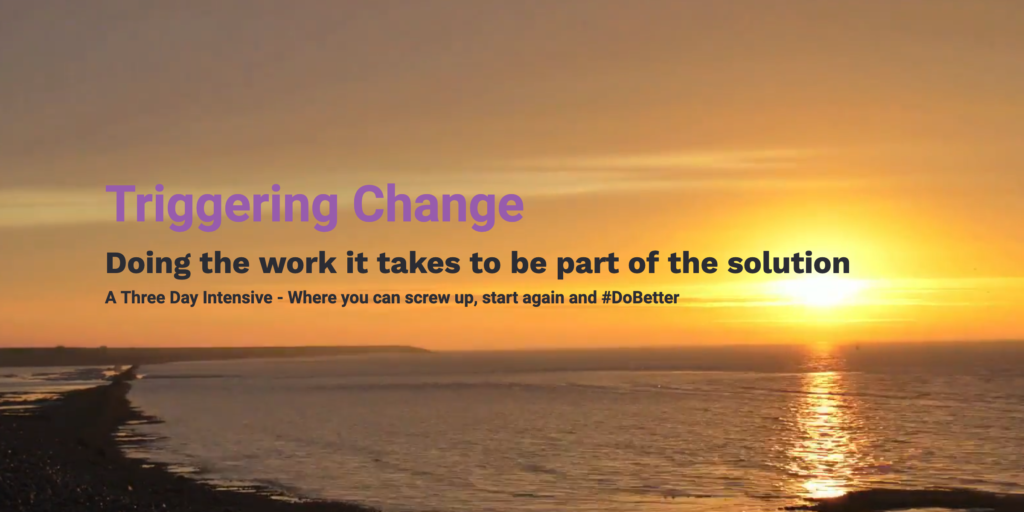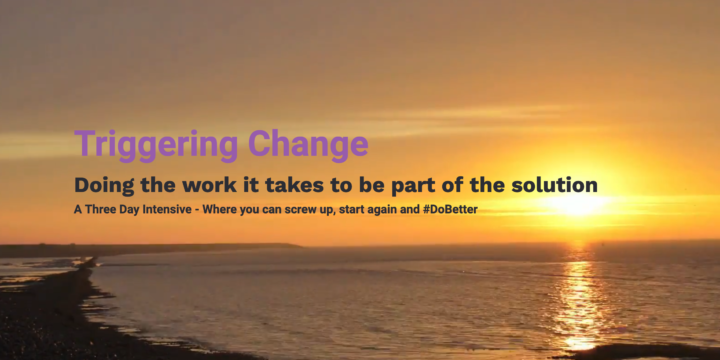The title was originally going to be “The Accidental Asshole: a safe place for people who thought they were woke”. You see, I’ve developed a program to provide participants the tools and practice to engage productively in the extremely difficult conversations – that are necessary to have if we are to move forward – about painful topics having to do with privilege, complicity, inequity and inaction. But after doing some initial design and sharing that design with peers, colleagues and potential participants – some of whom are Black, others who are gay, many who are women, two who are from the South and one who is a middle aged white man of Irish decent and a member of a union, I changed the title. I changed the whole program and it’s better now. I haven’t even done it yet and I know it’s better.
By engaging a diverse network of people in the assessment of and the ideation for this program, I was able to see the potential I had overlooked and the pitfalls I had inadvertently dug for myself when left to my own devices. This is what we mean by diversity and inclusion. Developing networks that represent different races, genders, ages, orientations, classes, perspectives and so on, and ensuring the people in that network feel welcome, valued and connected. Seen.
But that is not the work. That is good – don’t get me wrong. But it’s relatively easy to decide to recruit more Black professionals into your organization, gather a Diversity & Inclusion committee from among your interested employees and celebrate Gay Pride Month and Chinese New Year on the intranet. It’s also easy to hire a facilitator to conduct unconscious bias, anti-discrimination, gender equity and anti-harassment training. No, the real work is much much much more difficult than creating and maintaining a diverse network where people feel safe and included.
The real work is at the individual level. The real work is holding ourselves and others accountable for what we say is important. The real work takes many different shapes but includes things like:
- Exiting people from your organization who exhibit racism even if (especially if!) they are strong producers
- Speaking up when you observe discrimination, oppression, microagression and racism
- Exploring why the word microagression gets your back up even though you don’t really know what it means, haven’t actually looked the word up and haven’t had a conversation with someone who experiences it in order to find out
- Purposefully expanding your own personal network to include BIPOC (People who are Black or Indigenous and People of Color)
- Stopping to reflect on why you roll your eyes or sigh in over-burdened frustration when you learn there’s a new acronym to describe a group.
Honestly, the To Do list of this work would take all the bits and bytes Word Press has to offer. The thing is, the point is not to check the items off the list to make it all go away and be done with it. That attitude and approach has only gotten us this far and it’s clearly not far enough. No, the point is to look, each of us, deeply, at how we can stop participating in – and thereby perpetuating – systems that benefit one race over another, how we can stop the self-fulfilling prophecy of power – be it white supremacy, cis-gendered normalcy or gender inequity – and how we can better engage in the dialogue and discipline of human connection that never stops changing and will always present a longer list.
But before we start this work, we must prepare ourselves. At least one of the words I’ve used so far – or will use someday – will get your back up. It will strike a nerve and you will want to take me or the BLM movement or the Black community or women to task for not saying it right or for saying something very very hurtful and wrong. And your job, if you want to be part of the solution, is to honor and hold that reaction and decide who you want to be and select your path forward to result in understanding instead of acrimony. This is why I created the Triggering Change program.
Why Triggering Change?
One can experience a “Triggering Change”
Triggering: threatening, causing reaction, causing offense
Change: a new idea, changed reality, altered worldview
Therefore, a triggering change can be thought of as an intense visceral experience of being exposed to threatening new ideas and learning to open to, explore and assimilate them.
One can also “Trigger Change”
Trigger: to start, catalyze, impel, begin, cause, make
Change: to shift, morph, transform, modify, replace
So in this case, to trigger change is to cause a transformation in yourself and your world with the tools offered in this course.
The Triggering Change program is an intense, visceral experience of vulnerability and self-reflection where you will gain deeply personal and highly practical insights, ideas, tools and direction designed to inspire you to engage fully and contribute meaningfully.
Hence the title, “Triggering Change: The work it takes to be part of the solution”.
I invite you to join in this invigorating journey with me. This will be hard work. Learn more and register here.

Register here: https://bit.ly/3h7Wy2Fhttps://bit.ly/3h7Wy2F


 Everything you need to become everything you want
Everything you need to become everything you want